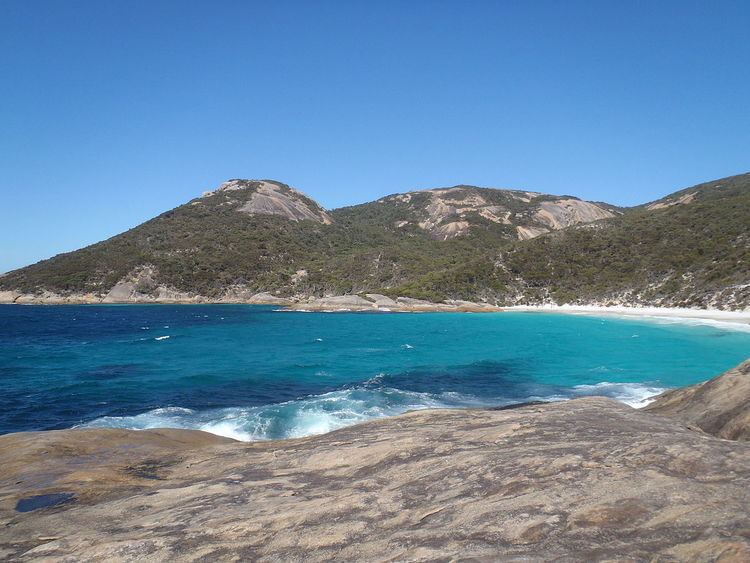 | ||
Similar Amity, Dog Rock, Torndirrup National Park, National Anzac Centre, West Cape Howe National | ||
Little beach two peoples bay nature reserve
Two Peoples Bay Nature Reserve is a protected area managed by the Department of Parks and Wildlife 35 kilometres (22 mi) east of Albany, Western Australia. The area is accessible by 2WD vehicles. The bay itself, including two small secluded beaches, faces due east and is protected from the Southern Ocean by a headland formed by the granite massif of Mount Gardiner. The nature reserve was established in 1967 to protect the threatened noisy scrub-bird and its habitat.
Contents
- Little beach two peoples bay nature reserve
- History
- Facilities
- Plants
- Animals
- Birds
- Geographic features
- References
History
The name "Two Peoples Bay" is from an incident in 1803 when an American whaling ship used the sheltered waters to lay anchor at the same time as a French vessel that was exploring the coastline east of Albany.
John Gilbert, a naturalist, surveyed the area in the 1840s giving his name to the Gilbert's potoroo and discovering the noisy scrub-bird. Two Peoples Bay was declared a nature reserve in 1967.
A bush fire broke out on private land near the reserve on 12 October 2012 and a team of about 20 fire-fighters arrived to combat the blaze. Following a sudden change in wind direction a truck carrying two of the fire crew was engulfed in flames. The two DEC firefighters, both female, received terrible burns. One, 45 years old, received burns to 60% of her body and was admitted to hospital in critical condition; the other, 24 years old, had burns to 40% of her body and was also critical. Both were transferred from Albany via the Royal Flying Doctor Service to Perth. Three other fire crew were injured, a second truck was burnt out and over 1,000 hectares (2,500 acres) of bushland were burnt before the fire was contained later the same day. The older woman, Wendy Bearfoot, died in Royal Perth Hospital on 1 November as a result of her injuries. WorkSafe launched an investigation into the circumstances.
In late 2015 a fire burnt through 1,200 hectares (2,965 acres) of the reserve destroying an estimated 90% of the Gilbert's potoroo habitat.
Facilities
Two Peoples Bay boasts unspoilt coastal scenery and is a vital area for threatened animal species. There are beaches with path access that are suitable for swimming and snorkelling. Facilities within the reserve include a boat ramp, toilets and barbecues. However, there is no drinking water available and visitors need to take their own. There is no entry fee for the reserve.
Plants
The vegetation that is found in the park can be classified as follows: low forest is found north of Moates Lake, the wetland margins and close to the reserve offices. The trees reach 15 m in height and are dominated by Eucalyptus species including coast gum, jarrah and yate as well as other species such as marri and juniper myrtle.
The understorey of the low forest includes species such as swamp banksia, pea-flowered narrow-leaved water bush and the porungurup wattle. Low woodlands in the broad valleys north of Moates Lake mainly consist of Albany blackbutt and the area between Moates Lake and Gardiner Lake is mostly populated with swamp banksia. Dieback has eradicated a population of the threatened granite banksia.
Animals
Two Peoples Bay is home to Australia's most threatened mammal and one of the rarest animals in the world, the Gilbert's potoroo (Potorous gilbertii). This potoroo was thought to be extinct until the population at Two Peoples Bay was discovered in 1994. It is estimated that there are fewer than 40 individuals left in the wild. Other threatened mammals in the area include the southern brown bandicoot, western ringtail possum, Australian sea lion and the New Zealand fur seal. Quokkas are also known to inhabit the park and Two Peoples Bay is thought to be near the eastern limit of their range. Several reptiles can be found in the park including little brown snake, carpet python, beautiful skink and mournful skink.
Birds
The reserve forms part of the Two Peoples Bay and Mount Manypeaks Important Bird Area, identified as such by BirdLife International because of its significance in the conservation of several rare and threatened bird species. It supports a population of noisy scrub-birds, a species that was thought to be extinct until rediscovered in 1961. The population then was estimated at less than 100, while in 1994 it was thought to be around 1100 (of which 450 occur in the reserve). Other threatened birds inhabiting the reserve are the western ground parrot, western bristlebird, western whipbird and Australasian bittern. Other threatened bird species that have been observed within the park include short-billed black cockatoo, peregrine falcon, hooded plover, little bittern and red-eared firetail. Seabirds nesting on the islands around the bay include the great-winged petrel and flesh-footed shearwater.
Geographic features
The total area enclosed by the nature reserve is 4,744.7 hectares (11,724 acres). It consists of three separate areas:
